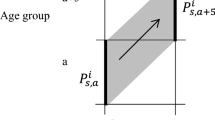Abstract
Population projections commonly suffer from a decreasing accuracy with a higher degree of disaggregation. We suggest combining the cohort-component model and an averaged projection technique to improve precision of forecasts for small areas. Calculating ex-post population projections, we evaluate the precision and bias of the proposed method by contrasting error patterns of commonly used techniques using official population data from 46 districts of a German state for the years 1980–2013. In comparison to the individual methods considered, the combined approach results in the highest accuracy and lowest bias both for the total population and for age groups. The proposed method is also more robust regarding past growth.






Similar content being viewed by others
References
Clemen, R. T. (1989). Combining forecasts: A review and annotated bibliography. International Journal of Forecasting, 5(4), 559–583.
de Beer, J., & Deerenberg, I. (2007). An explanatory model for projecting regional fertility differences in the Netherlands. Population Research and Policy Review, 26(5), 511–528.
Goodwin, P. (2009). New evidence on the value of combining forecasts. Foresight: The International Journal of Applied Forecasting, 2009(12), 33–35.
Isserman, A. M. (1993). The right people, the right rates: Making population estimates and forecasts with an interregional cohort-component model. Journal of the American Planning Association, 59(1), 45–64.
Keilman, N. (1998). How accurate are the united nations world population projections? Population and Development Review, 24, 15–41.
Preston, S. H., Heuveline, P., & Guillot, M. (2001). Demography: Measuring and modeling population processes. Oxford: Blackwell Publishing.
Rayer, S. (2008). Population forecast errors: A primer for planners. Journal of Planning Education and Research, 27(4), 417–430.
Rayer, S., & Smith, S. K. (2010). Factors affecting the accuracy of subcounty population forecasts. Journal of Planning Education and Research, 30(2), 147–161.
Rees, P. H. (1979). Regional population project models and accounting methods. Journal of the Royal Statistical Society, 142(2), 223–255.
Shryock, H., Siegel, J., and associates (1980). The Methods and Materials of Demography. Bureau of the Census: Department of Commerce.
Smith, S. K. (1987). Tests of forecast accuracy and bias for county population projections. Journal of the American Statistical Association, 82(400), 991–1003.
Smith, S. K., & Sincich, T. (1990). The relationship between the length of the base period and population forecast errors. Journal of the American Statistical Association, 85(410), 367–375.
Smith, S. K., & Sincich, T. (1992). Forecasting state and household populations: Evaluating the forecast accuracy and bias of alternative population projections for states. International Journal of Forecasting, 8, 495–508.
Smith, S. K., & Tayman, J. (2003). An evaluation of population projections by age. Demography, 40(4), 741–757.
Statistisches Bundesamt. (2011). Modell der bevölkerungsvorausberechnungen. Statistisches Bundesamt: Discussion Paper.
Stoto, M. (1983). The accuracy of population projections. Journal of the American Statistical Association, 78(381), 13–20.
Tukey, J. W. (1977). Exploratory data analysis. Reading, MA: Addison-Wesley.
U. S. Census Bureau. (2012). Methodology and assumptions for the 2012 national projections. Discussion Paper, U.S: Census Bureau.
Wilson, T. (2012). Forecast accuracy and uncertainty of australian bureau of statistics state and territory population projections. International Journal of Population Research, 2012. Article ID 419824.
Wilson, T. (2014). New evaluations of simple models for small area population forecasts. Population, Space and Place. Forthcoming.
Wilson, T., & Rowe, F. (2011). The forecast accuracy of local government area population projections: A case study of queensland. Australasian Journal of Regional Studies, 17(2), 204–243.
Author information
Authors and Affiliations
Corresponding author
Rights and permissions
About this article
Cite this article
Reinhold, M., Thomsen, S.L. Subnational Population Projections by Age: An Evaluation of Combined Forecast Techniques. Popul Res Policy Rev 34, 593–613 (2015). https://doi.org/10.1007/s11113-015-9362-0
Received:
Accepted:
Published:
Issue Date:
DOI: https://doi.org/10.1007/s11113-015-9362-0




